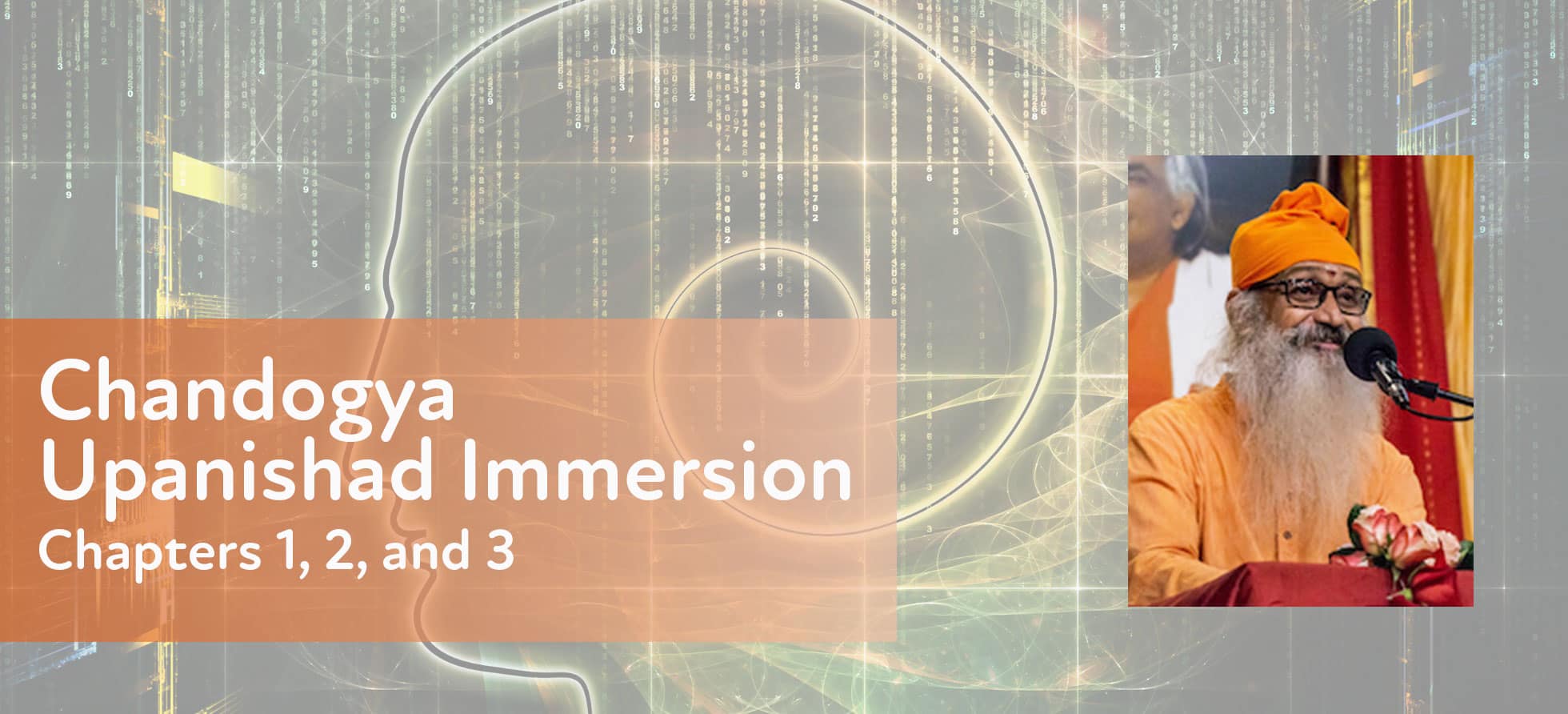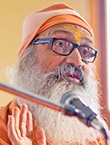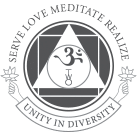
Chandogya Upanishad Immersion
Chapters 1, 3 and 6
What is the Chandogya Upanishad Immersion?
It is a 1.5 month of Vedanta Immersion offering a deep dive into the Upanishads.
What does the Chandogya Upanishad Immersion involve?
The Mahatma (great saint or sage), Swami Sharvananda Giri, will be chanting the original Sanskrit verses in the daily morning class from 8 to 10 am. Following the chanting, Swami Sharvananda Giri will will translate the verses to English and will teach the traditional commentary of Adi Shankaracharya and Ananda Giri. This method is the most authentic way to study and practice Vedanta and has been utilized for thousands of years in India to help spiritual speakers grasp the answers to such questions as: What is the Self? Who am I?
The practice of listening to a great saint or Mahatma relay the knowledge of the Vedas, ancient scriptural texts in India, has been the foundation for spiritual liberation for countless people. This immersion offers the doorway through which moksha or true freedom is attained.
It is not necessary to attend the entire 1.5 month immersion, but we ask that you if you do choose to join, to attend once per day during your stay—the immersion consists of 1 morning class from 8 am to 10 am, leaving plenty of time to attend both of the daily satsangs, one yoga class, both of the delicious vegetarian meals, as well as to enjoy the ashram grounds.
What is Vedanta?
Vedanta is a school of Hindu philosophy. It translates to the “end of the Vedas” or the “end of all knowledge”. It reflects the ideas that emerge from the study of the Upanishads, which deal with topics such as knowledge and liberation. Vedanta, or the study of the Vedas (the oldest scriptures of Hinduism), form the basis of Jnana Yoga, the Yoga of Knowledge.
What are the Upanishads?
The Upanishads are the most recent part of the Vedas, the oldest scriptures of Hinduism. While earlier parts of the Vedas deal with mantras, various benedictions, rituals, and ceremonies, the Upanishads deal with meditation, philosophy, consciousness, and various ontological knowledge (that is, the knowledge pertaining to the nature of being). In short, studying the Upanishads is studying what is Real and what is Unreal. It is the study of the Self.
What study Vedanta? Why partake in the immersion? What are the benefits of studying with a Mahatma like Swami Sharvananda Giri?
This course is a classical example of the practice of Jnana Yoga (the Yoga of Knowledge), which consists of:
- Savanna, listening to the teachings of the Upanishads
- Manana, reflecting on their meanings
- Nididhyasana, divining into deep meditation on the insights that one receives from the reflection
Mahatmas such as Swami Sharvananda Giri are among the most senior teachers of traditional Advaita Vedanta in India. They rarely—if at all—travel to the West/anywhere outside of India. In India, Mahatmas teach in the most traditional high Vedanta institutions such as the Kailash Ashram. These spaces are not even accessible to lay people!
10 years ago, Swami Swaroopananda, the acharya or spiritual director of our ashram, started to invite these Mahatmas to come to the Bahamas for a long stay (1-3 months) to teach in-depth intensive Vedanta Courses. He did so to allow the ashram’s Swamis, Brahmacharis, and senior staff the opportunity study Vedanta in the appropriate, traditional, and authentic way. These courses are open to all who are at the ashram (guests, karma yogis). They are offered for free and there is no tuition for attending the courses.
What will you study with Swami Sharvananda Giri in Chapters 1, 3, and 6 of the Chandogya Upanishad?
In Bhagawad Geeta Bhagawan Shri Krishna Says “Vedanam Samaveda Asmi” – Among Vedas I am Sama Veda.
Our Chandogya Upanishad is from Samaveda Talavkar Branch and of Chandogya Brahmanas. Actually, it is consisting of 10 chapters. Since the first 2 chapters are of Karma only, Bhagawan Shankaracharya did not write any commentary on them.
Among the following 8 chapters, the first 2 chapters are describing upasana as a part of karma. These chapters state that those who are performing Jyotistoma sacrifice are the ones eligible to perform the upasana. The essential part of Jyotistoma sacrifice is Sama gana (singing the sama mantras). It is of two types: (1) having 5 folds and (2) gaving 7 folds. The name of the middle fold is Udgeetha.
- Chapter 1 of this Upanishad has 13 khanda relating to the Udgeetha upasana, which is in turn related to Karya Brahma (Brahman with different names and forms).
- Chapter 6 of the Chandogya Upanishad contains the famous “Tat Tvam Asi” (“That Thou Art”) precept. Tat Team Asi is regarded by scholars as the sum-total or one of the most important of all Upanishadic teachings. The precept is repeated nine times at the end of sections 6.8 through 6.16 of the Upanishad.
The basic idea of this Upanishad is to show us how can we practice seeing Brahman in our daily life, in all interactions, in every person we encounter, in every sight that we, in every object that we use, and so on.
- In part 6.9, the Chandogya Upanishad states that all Selfs are interconnected and one. This part concerns itself with the fact that the inmost essence of all beings is the same, that the whole world is One Truth, One Reality, and One Self.
These all are independent upasanas. They do not require the actual performing of sacrifice. One can do directly do upasana; e.g. as in the worship of the sun god through Madhu Vidya, Gayatri Upasana, Shandilya Vidya (Upasana of Karya Brahman), etc.
By Practising any one of the upasanas detailed in this Upanishad, the sadhaka can reach up to Brahma loka. When this reaching is done without any expectation of result, what results is the purification of the sadhaka’s chitta. This directly leads to liberation.

Swami Sharvananda Giri Maharaj started his training under the personal tutelage of the great Vedantin Swami Chaitanyananda Sarasvati in 1984. He took his monastic vows in 1991 and mastered the entire Prasthana Traya and Sanskrit grammar.
Swamiji was appointed as the acharya of the renowned Kailash Ashram in Uttarkashi and elected as the president of the Sadhu Samaj. He serves as the president of Chaitanya Tapovan Trust and vice president of Adi Shankara Brahmavidya Peeth.
Swamiji has expert knowledge over vast Vedantic literature as well as fluency in Sanskrit, Hindi, English, and Bengali.
Let's Stay In Touch
Join our email list to learn more about our in-person and online programs, courses, and free events.







